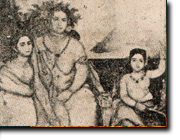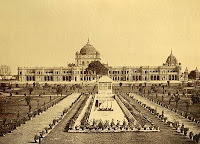Omana Thingal Kidavo
തമ്പിമാമന്ടെ താരാട്ട് - Uncle Iravivarman Thampi’s Royal Lullaby
One could go north or south in Kerala, through the various regions, where they talk different dialects, think somewhat differently even, where the Malabar aristocrat sometimes subtly expresses his mistrust of the Travancore person or vice versa, where even the food habits and spoken dialects change with the terrain, but there is one thing they will all agree to, that the ‘Malayalee standard’ lullaby is Omana Thinkal Kidavo penned by the illustrious Irayimman Thampi for his young nephew Swati Tirunal Rama Varma. Most children would have grown up listening to someone in the house humming this song, for it is a dear memory in many a Malayalees childhood. It was a desire to sing it for our recent Samaroha that made us check the background in detail.
As I checked, I came across quite a few versions and at least 12 or so recordings, done in the raga’s Hindolam, Arabhi, Nellambari, Kurinji, Kanada, Sankarabharam or even the Hindustani Desh by Bombay Jayashree. While the most apt version in my mind is Janaki’s short one in Kurinji, the smoothest and complete ones are by Omana Kutty and Chitra. The version by Yesudas is quite a change from the normal.
But to understand the significance of the song and its impact, one must go back in times, to the period slightly before Swati Tirunal’s birth in 1813. The kingdom of Travancore was in a troubled state, for there was no male heir to the throne and there was a chance of the kingdom being taken over by the British under the so called Dalhousie doctrine of lapse. According to the Doctrine explained in Wikipedia, any princely state or territory under the direct influence of the British East India Company, as a vassal state under the British Subsidiary System, would automatically be annexed if the ruler was either "manifestly incompetent or died without a direct heir". The latter supplanted the long-established right of an Indian sovereign without an heir to choose a successor. In addition, the British decided whether potential rulers were competent enough.
Nobody in Travancore, including the then British resident Col. Munroe (apparently) wanted the kingdom to be annexed to British India. It was with great relief that the news of Rani Lakshmi Bayi’s pregnancy was announced. It appears that Col Munroe himself prayed at the Padmanabha Swami temple for a boy to be born and even announced the boy’s birth to his superiors even before he was born. And so, while he was still unborn, Swati Tirunal was declared to be the next ruler. This special circumstance earned him the title of ‘Garbha Sriman’ (glorified even when he was in the womb). When he was barely four months old, the Maharani proclaimed him the Maharaja, and dedicated him as the obedient dasa of Lord Padmanabha, on whose behalf; he was destined to rule the State of Travancore. Which he did as we all know for but a short span of 33 years.
Uncle Irayimman Thampi, the learned poet of the family was entrusted the task of creating a royal lullaby which he did in inimitable fashion, in the tradition at that time, being Manipravalam (mixture of Sanskrit and Malayalam) the Malayalam poetic fashion, rather than pure Sanskrit. Paravathi Bayi could hum this song for her son, unfortunately, only for two years for she passed away in 1815. But the song left its mark on the young boy who rose to become a musical prodigy. The people of Kerala agree that it is the most beautiful and melodious composition of the times to date and is more a peoples lullaby rather than just the royal lullaby. As you hear it today, it continues to strike the same tender chord in ones mind and the feelings are testimony to the clarity, purity and brilliance of the composition. Avid listeners would have noted that the lullaby does not ever mention anything about sleep! Unlike other poems which simply provide superlatives of the human, this composition compares the young regent to various lovely aspects of nature and goodness.
 |
| Swati Tirunal as a child |
As Fox Strangways aptly put it in his Music of Hindostan (or was it really some other Englishman, I am not sure for I could not trace this quotation in the book) - Generations of children have been lulled asleep by its soothing notes. Sung by generations over centuries the strains of this lullaby have been dyed into the warp and woof of the Malayalee’s cultural repertoire. Evoking intense nostalgia for a bygone phase of one’s life filled with tender affections and motherly care, the lullaby also thrills one with a sense of dejavu.
Omana Thingal', to put it simply is a lullaby which depicts the different feelings going through the mothers mind as she puts her baby to sleep. Music lovers also believe that the flowering of Swathi Thirunal's musical creativity owes a lot to Thampi's great lullaby. Anyone who has listened to the lullaby and also to Swathi's music will find it easy to agree. It is said by experts that this is possibly the first composition in the language which has attributes to a modern poem with many upamas or comparisons.
Irayimman Thampi (1783-1863), Swati Tirunal’s maternal uncle, who contributed three other masterpieces, Keechaka Vadha, Daksha Yagam and Uttara Swayamvaram and many hundred other compositions was the composer of Omana Thinkal Kidavo. Irayiman Thampi and his wife Kalli Pillai Thankachi were blessed with seven children including a daughter Kutty Kunju Thankachi (1820-1914) who continued her father's artistic and poetic legacy. Thankachi inherited the literary talents of her father and wrote three Kathakali plays: Srimathi Swayamvaram, Parvathi Swayamvaram and Mitrasaha Moksham. There is so much more to write about the poet but suffice to say that he was a great composer and very close to Swati Tirunal. In fact they both had the same Mudra or signature, being Padmanabha, resulting in many of his compositions even being wrongly attributed to Swati Tirunal, according to some experts.
Sadly Thampi who gave us this marvelous and ecstatic lullaby also had to endure the agony of composing Swati Tirunal’s death chant or Charama sloka. Thampi is also the author of the melodious Karuna cheyvan enthu and many others…
References
Please click the following links for a detailed write-up’s of Thampi
Pics
Swati as child – Swatitirunal website
Thampi – B&W image
The song sung by the maestros
Lyrics & meaning
 |
| Click image to enlarge |
This is a light article on Iryimman Thampi’s and his music as related to Swati Tirunal. The next one will cover a very interesting story of how the uncle created a poem for Swati Tirunal’s favorite courtesan Sugandhavalli, after her lovers tiff with the king.






Comments
Post a Comment